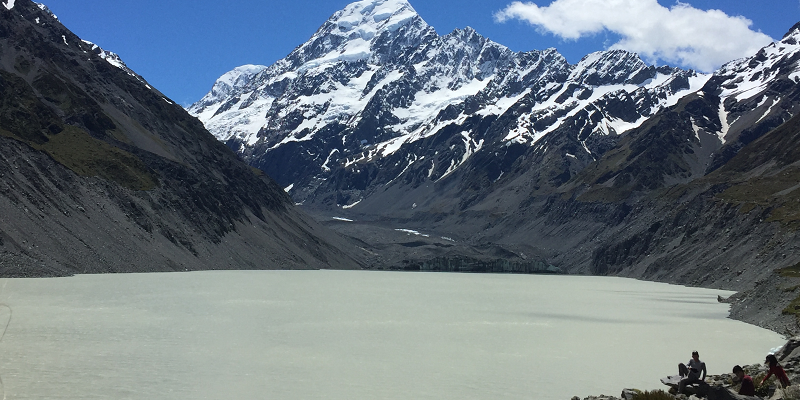Aug 10 2020
A new study reports that glaciers in New Zealand’s Southern Alps have lost higher amounts of ice mass since pre-industrial times than what remains at present.
 View from December 2018 across Hooker Lake to Aoraki - Mt Cook with Little Ice Age moraines and trimlines encircling the lake. Image Credit: Jonathan Carrivick, University of Leeds.
View from December 2018 across Hooker Lake to Aoraki - Mt Cook with Little Ice Age moraines and trimlines encircling the lake. Image Credit: Jonathan Carrivick, University of Leeds.
Headed by Dr Jonathan Carrivick from the School of Geography, together with the National Institute of Water and Atmospheric Research (NIWA) in New Zealand, the study involved mapping the ice loss in the Southern Alps since the end of the Little Ice Age, approximately 400 years ago, to 2019.
The researchers discovered that the ice loss rate has increased two-fold since glaciers were at their Little Ice Age peak extent. With respect to recent decades, the Southern Alps lost nearly 77% of their total Little Ice Age glacier volume.
There has been a considerable effect of climate change on ice loss across the globe. Besides the fact that local communities rely on glaciers as sources of freshwater, irrigation, and hydropower, melting of mountain glaciers and ice cap currently contributes 25% of the worldwide sea-level rise.
Understanding the global sea-level contributions, local landscape evolution, and regional climate-glacier systems require researchers to place the fast changes noticed at present for mountain glaciers into a longer-term context.
Reported in the Scientific Reports journal, the study calculated changes in volume for 400 mountain glaciers over the Southern Alps for three time periods—the pre-industrial Little Ice Age to 1978, 1978 to 2009, and 2009 to 2019.
Glacier volumes were reconstructed by the researchers with the help of historical records of glacier outlines. They also used investigations of trimlines and moraines, which are clear lines on the side of a valley formed by a glacier and accumulations of glacial debris, respectively. Trimlines and moraines can point to previous ice margin extent and variations in ice thickness over time.
As part of the study, variations in the glacier surface reconstructed for the Little Ice Age peak and the glacier surface in the latest digital elevation models were compared. Consequently, it was found that ice loss has doubled since the Little Ice Age, with a very fast increase in the loss of ice volume in the past four decades.
From 1978 to 2019 alone, nearly 17% of the volume present at the Little Ice Age was lost. In 2019, only 12% of the ice mass was left in what was previously the low altitude part of the Little Ice Age glacier region—also known as the ablation zone—and a major portion of what used to be ice-covered in the Little Ice Age ablation zone is totally free of ice at present.
These findings quantify a trend in New Zealand’s ice loss. The acceleration in the rate of ice mass loss may only get worse as not only climate but also other local effects become more pronounced, such as more debris accumulating on glaciers surfaces and lakes at the bottom of glaciers swell, exacerbating melt.
Dr Jonathan Carrivick, Study Lead Author, University of Leeds
Dr Carrivick added, “Our results suggest that the Southern Alps has probably already passed the time of ‘peak water’ or the tipping point of glacier melt supply. Looking forwards, planning must be made for mitigating the decreased runoff to glacier-fed rivers because that affects local water availability, landscape stability and aquatic ecosystems.”
According to Dr Andrew Lorrey, co-author of the study and a Principal Scientist based at NIWA, “The long-term ice volume decline, rising snowlines, and rapid disintegration of glaciers across the Southern Alps we have observed is alarming. Photographic evidence that has been regularly collected since the late 1970s show the situation has dramatically worsened since 2010.”
Our findings provide a conservative baseline for rates of Southern Alps ice volume change since pre-industrial times. They agree with palaeoclimate reconstructions, early historic evidence and instrumental records that show our ice is shrinking from a warming climate.
Dr Andrew Lorrey, Principal Scientist, National Institute of Water and Atmospheric Research
Journal Reference
Carrivick, J. L., et al. (2020) Ice thickness and volume changes across the Southern Alps, New Zealand, from the little ice age to present. Scientific Reports. doi.org/10.1038/s41598-020-70276-8.